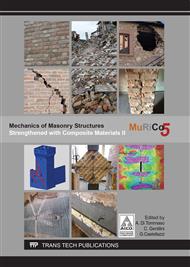p.212
p.220
p.226
p.234
p.242
p.250
p.258
p.266
p.274
In Situ-Tests and Advanced Numerical Modelling for Masonry Arches Retrofitted with Steel Reinforced Grout
Abstract:
The paper presents the results of a series of In Situ tests carried out on two masonry arches, one unreinforced and the other reinforced with SRG (Steel Reinforced Grout). An advanced numerical modelling based on a heterogeneous discretization is also reported. The arches have a span equal to 3.30 m and height 0.83 m, and are built with common Italian bricks with dimensions 250x120x55 mm3 and 10 mm thick mortar joints. The arches are built regularly spacing out two bricks laid edge on (thickness of the arch 12 cm) with two bricks (one over the other) disposed in single leaf. One of the two arches is tested unreinforced, whereas the second is reinforced with an SRG constituted by an inox grid embedded into a layer of lime mortar. For all samples, an eccentric vertical load placed at 1⁄4 of the span is increased up to failure. An advanced numerical technique is adopted to reproduce experimental results, namely a heterogeneous micro-modelling where bricks, mortar and strengthening are meshed separately. The numerical outcomes are comparatively assessed with respect to the experimental global behavior and crack patterns obtained at the end of the tests.
Info:
Periodical:
Pages:
242-249
Citation:
Online since:
July 2017
Price:
Сopyright:
© 2017 Trans Tech Publications Ltd. All Rights Reserved
Share:
Citation:


